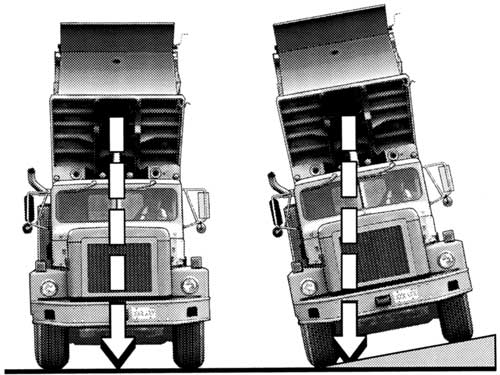Summary Statement
As end-dump truck bodies and semi-trailer dumping rigs get longer, the incidence of units tipping over has increased. Discusses ways to avoid the problem through increasing stability, being aware of the hazards and improving maintenance.
Spring 2001
The Hazard
As end-dump truck bodies and semi-trailer dumping rigs get longer, the incidence of units tipping over has increased. This type of accident is more frequently connected with semitrailer rigs than with straight trucks.
In the last couple of years, one fatality and at least one serious injury have resulted when dump trucks tipped over. Statistics on the frequency of tip-overs are not available because the occurrences are not reported unless injuries result. However, construction personnel involved in dump truck operations agree that tip-overs are becoming more frequent.
An industry labor-management committee formed to address this problem strongly recommends that the construction and trucking sectors become aware of the hazard, the contributing conditions, and the methods of control set out in this advisory.
Stability
The main hazard is related to the stability of the end-dump unit when the box is in the raised position.
When the center of gravity of box and load is not roughly between the frame rails of the unit, there is a risk of tip-over (see diagram).

A slight slope can be enough to cause tipping if material sticks in
the top of the box.
Stability is adversely affected by one or more of the following factors:
- the unit is not on a level surface when dumping
- a large amount of material is in the upper portion of the raised box
- material does not flow out of the top portion of the box, or does not flow out of one side of the top portion
- the rear wheels settle unevenly as the load moves to the rear during dumping
- wind may exert lateral loads, especially if the box is long, as is the case with end-dump semi-trailers.
Stability may also be affected by the unit's mechanical condition:
- poor rear suspension systems on one side of the vehicle
- uneven tire pressures in rear wheels
- worn or inadequate components of the lifting system such as pins
- worn or inadequate lifting cylinders.
Hazard Control
Because of stability problems with semi-trailers, they should not be used for haulage to rough grading or fill areas where surfaces are often uneven or loosely compacted. Straight trucks or straight trucks and pup trailers are more appropriate for highway haulage to these dump areas. Where haulage and dumping are all on site, straight trucks or off-highway vehicles are even better choices.
Where aggregates are being spread for road construction, belly-dump semi-trailers are more appropriate than end-dump semi-trailers.
Sometimes vehicle selection is not an option for the contractor. Material suppliers or haulers do not always use equipment appropriate to a particular site. However, when contractors do have a choice they should select equipment in accordance with these recommendations to reduce tip-overs.
Cold weather may cause materials to freeze to the box and stick when dumping. Using heated boxes will reduce the problem. During winter, loads should not be left in dump boxes overnight.
Maintenance
Maintenance can play an important role in preventing tip-overs.
- Check tire pressures daily. Tire pressures should be equal on each side of the vehicle.
- Examine and lubricate pins and bushings regularly.
- Inspect suspension systems under load to ensure that they work properly and provide even suspension. Weak suspension systems should be replaced immediately.
- Inspect hoist cylinders regularly. Worn cylinders should not be replaced with smaller cylinders or with cylinders rated at lower operating pressure.
- Make sure that repairs to boxes leave bottom and sides clear and unrestricted. Rough patchwork repairs near the top of the box can catch and hold sticky materials.
Loading
Loading of the box front-to-back must meet allowable gross weight and axle weight limitations set by the Ministry of Transportation. From side to side it is best to load as evenly as possible.
If material is likely to flow poorly, lighten up the load in the top end of the box. A slightly smaller load will be better than a full load that causes a tip-over.
Box liners will help most materials flow better during dumping. Liners also help to keep the box in good condition.
Dumping
Operators should be trained to recognize areas hazardous to dumping, such as soft or uneven surfaces and inadequately compacted fill.
Before dumping, operators should ensure that the tailgate is unlocked and that the vehicle is on a reasonably level surface. Dumping on surfaces that are not level is one of the main causes of tip-overs.
Before spreading material by dumping it from a moving truck, make sure that the entire length of travel is reasonably level.
Trucks should not dump when they are parked side by side with another vehicle. When a dump unit tips over, it is often the operator in the adjoining vehicle who is injured. Dumping operations should be spread out.
Other personnel such as dozer operators, surveyors, and spotters should be warned not to work near a dumping truck in case it tips over.
Workers on foot should not congregate in areas where dumping is under way.
Information
For additional copies of this advisory, contact:
Construction
Safety Association of Ontario
21 Voyager Court South
Etobicoke, Ontario M9W 5M7
Tel:
(416) 674-2726
Fax: (416) 674-8866 1-800-781-2726
http://www.mdrao.ca/
admin@mdrao.ca


